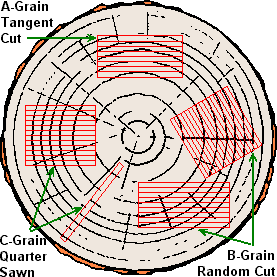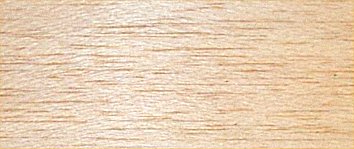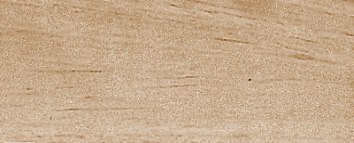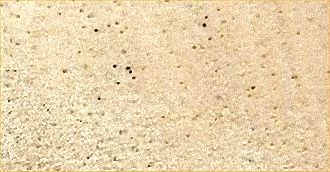|
|
|
|
|---|
|
|
Selection of Balsa Wood for Flying Model Construction |
|---|
Balsa wood (ochroma lagopus) has been one of the main materials for model aeroplane construction since about 1920. Balsa is light, but with high strength, it absorbs the shock and vibration of heavy landings quite well and can be easily worked with hand tools. It's lightness is due to the microscopic structure of large water filled cells, that when dried become empty lignin skins holding nothing but air.
Balsa trees grow rapidly in the humid rain forests of Central and South America. Ecuador has the ideal geography and climate for growing balsa trees, situated on the western coast of South America, it has become the primary source of model aircraft grade balsa wood.
The balsa wood business started during World War I, when a substitute for cork life jacket floats was required. The drawback in harvesting balsa is the need to manually harvest each tree as it only grows as individual specimens within fairly thick jungle.
Green balsa wood has to be kiln dried to remove most of the water before it can be sold. The kiln drying process is slow (2 weeks) and removes the excess water down to a moisture content of only 6%. The action of the kiln drying also kills bacteria, fungi, and insect grubs/eggs that may have been in the original balsa wood tree.
Finished balsa wood, like you would use for model aeroplane construction, varies considerably in density and grain. Balsa can be found weighing as little as 4 lb per cubic ft up to 24 lb or more per cubic ft (65 to 360 kg/m3). Commercially available balsa for models will weigh between 6 and 18 lb per cubic ft (95 to 285 kg/m3). Eight to twelve pound balsa (120 to 192 kg/m3) is most plentiful and is considered medium or average weight. The six pound (95 kg/m3) or less is considered "contest grade" owing to good lightness, although durability due to inherent weakness is not a priority and such light examples can be rare or even impossible to obtain. Light grade balsa is nominally 6 to 8 lb per cubic ft (95 to 135 kg/m3). The denser the balsa wood, the stronger and harder it is, so sometimes a trade off can be made by using a more dense material that is thinner, but weighs about the same for a given strength.

Balsa Log conversion to planksGrain type and direction determine the rigidity or flexibility of a balsa sheet more than density does. The image at right shows how a log is converted into planks with different properties, an A grain sheet, cut from the log so that the tree's annular rings run across the thickness of the sheet it will be fairly flexible from edge to edge. On the other hand, if it is C grain, cut with the annular rings running parallel to the surface of the sheet, it will be stiff and rigid edge to edge. If the grain direction is less clearly defined as in B grain, the sheet will have properties intermediate between A and C types. B grain is the most abundant and is suitable for most jobs. As B grain is most common, it can be available in surplus quantities quite cheaply, so the model builder may have a surfeit of this type of grain... This can be overcome by making formers and wing ribs from this type of grain and then lightening the items by cutting circular holes, then covering with thin tissue that can be shrunken and doped to give a much stiffer item that is resistant to splitting. Whenever you come across good examples of A-grain or C-grain sheets, learn where to use them to take best advantage of their special characteristics. |

A-Grain also known as a Tangent cutA-Grain has long fibres that show up as long grain lines against a smooth creamy background and is very flexible across the width of the sheet, it warps easily and readily bends around curves, but lacks stiffness. Use for sheet covering tightly rounded fuselages and curves and fabricated wing leading edges (D-boxing), forming tubes, strong yet flexible spars that can withstand 'hard landings', hand launched glider fuselages.
|

B-Grain also known as Random or Mixed grain cutGrain lines are shorter than type A, and it feels noticeably stiffer across the sheet. These B grain sheets vary a great deal in properties, often a single sheet will vary from A to C grain across it's width. This cut of balsa wood is useful for general purposes... Use for flat uncomplicated fuselage sides, trailing edges, wing ribs, formers, planking of soft gradual curves, wing leading edge sheeting (select the softest portion of sheet for the tightest curvature). Generally, try to avoid buying sheets that change grain type dramatically across the surface (which can cause warping). If A or C grain is not available, you can sometimes find a portion of a B grain sheet that will make the part concerned. Occasionally, a variable grain structure may suit a particular part that requires different characteristics in different areas, but such occasions are rare.
|

C-Grain also known as a Quarter grain or Quarter sawnThis grain type has shorter, more mottled grain and is the most pleasant in appearance, sometimes looking like fish scales (occasionally the fish scales are of 'shot silk' iridescent appearance). It is very stiff across the sheet, is brittle and splits easily (sometimes too easily) longitudinally. This is the most warp resistant type, but it is difficult to sand effectively. Use for sheet balsa flying surfaces, fins, flat fuselage sides, wing ribs, formers, trailing edges.
|

End Grain also known as a Cross grainThere is a forth way of cutting balsa wood which involves cutting thin slices perpendicular to the run of the grain, this has very little application in model aircraft apart from the very largest models that may be a quarter scale. The cross grained pads are used as fillers between stiff outer sheets to form laminated composite materials that are light and yet stiff. |
Model supply outlets will have a large display of balsa sheets, sticks, profiles and blocks that you can choose from if you are going to build a model from scratch. When you select the pieces you wish to purchase you should keep their final use in mind. The lightest grades should be reserved for the lightly stressed model parts... Nose blocks, wingtip blocks, fillets, etc. and the heavier grades kept for important load bearing parts of the structure... Spars, stringers, motor peg mountings and so on. To a large extent, this selection process is already partly done for you by the materials supplier, who will purposely cut the lightest raw balsa into blocks and the heavier grades into sticks and strips. Sheets can be cut from the whole range of possible densities.
When selecting balsa sheets for use in your model, it is important to consider the way the grain runs through the sheet as well as the density of the sheet. The grain direction governs the rigidity or flexibility of a balsa sheet more than the density does. For example, if the sheet is cut from the log so that the tree's annular rings run across the thickness of the sheet (A-grain, tangent cut), then the sheet will be fairly flexible edge to edge. In fact, after soaking in water some tangent cut sheets can be completely rolled into a tube shape without splitting. If on the other hand the sheet is cut with the annular rings running through the thickness of the sheet (C-grain, quarter grain), the sheet will be very rigid edge to edge and cannot be bent without splitting. When the grain direction is less clearly defined (B-grain, random cut), the sheet will have intermediate properties between A and C types. Naturally, B-grain is the most common and is suitable for most jobs.
Laminating Balsa sheets can change the properties significantly as can laminating balsa with other materials like birch ply or plastic foam. Ply structured from sheets that have the grain direction alternating at right angles for each layer can have two different characteristics depending on whether the part concerned is cut with the long axis along one of the grain lines or cut on the bias. Bias cut parts will be somewhat more flexible and able to resist shock without cracking or splitting.
Written... 21 to 25 May 2007,
|